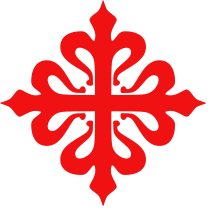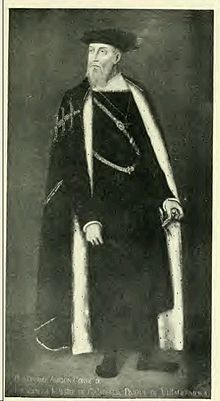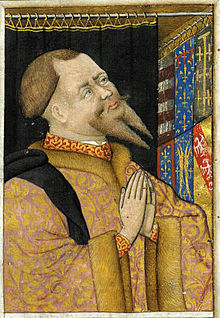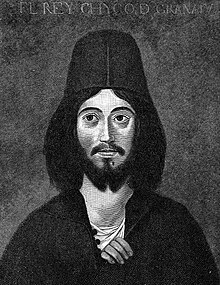Alfonso of Aragon and Escobar
Alfons of Aragon and Escobar in Catalan Alfons d'Aragó i d'Escobar in Spanish Alfonso de Aragón y Escobar also Alonso de Aragón y Escobar (* 1415 in Olmedo in Castile; † 1485 in Linares) was a Spanish military leader. He was Grand Master of the Order of Calatrava , first Duke of Villahermosa and Count of Ribagorza .
origin
Alonso was an illegitimate son of the Aragonese Infante John , then Duke of Peñafiel , the later King John II of Navarre and Aragon and Leonor de Escobar. He was a half-brother of Charles of Viana and of Ferdinand II of Aragon. He received his education at the court of King John II of Castile, his father's cousin, and at the court of King Edward of Portugal from his aunt's husband. He was knighted by John II of Castile .
Act

Grand Master of the Order of Calatrava
The Order of Calatrava was one of the four great orders of knights that emerged in Spain during the Reconquista . Ferdinand I of Aragon, Alfonso's grandfather, came from Castile. Ferdinand's sons, the Infantes de Aragón , had a great influence in Castile due to their position and property. Alfons' uncle, the Infanta Heinrich, was Grand Master of the Order of Santiago .
When a new Grand Master of the Order of Calatrava was elected on August 18, 1443, Henry was present with a number of soldiers and influenced the election so that his nephew was elected. On October 9th, Alfons received news of his election and accepted the election on October 12th. Since he was not a member of the order so far, he entered the order as a brother on February 2, 1444. From February 13, 1444 he exercised his office.
When the influence of the Infantes de Aragón in Castile waned in the middle of 1444, they were forced to withdraw from the Kingdom of Castile. Alfons made the Order's castle in Castillo de Alcañiz in Aragon his seat as Grand Master and received the income from the Order's lands in Aragon, Catalonia and Valencia. In the Battle of Olmedo Alfons fought against King John II of Castile at an important point in the army of the Castilian nobility . The outcome of the battle led to the final loss of influence of the Infantes of Aragón. The leadership of the Order of Calatrava claimed to have elected Alfons only under duress and on September 19, 1445 elected Pedro Girón as the new Grand Master. Alonso did not acknowledge his removal. In a warlike action in 1451 he tried to occupy Almagro in Castile, the then headquarters of the Order of Calatrava. The action failed and Alfons withdrew to Aragon. In a public statement, Alfons resigned from office in Saragossa on March 4, 1455. But he still hadn't given up his hope for the office. It was only after his marriage in 1477 that a return to the office was no longer possible.
Alfons' father Johann married Blanka von Navarra in 1420, who was then heir to the throne of the Kingdom of Navarre . When Blanka's father Karl III. of Navarre died in 1425 Blanka and Johann became reigning queen and reigning king of Navarre together. When Blanka died in 1441, according to the wills of Charles III. and Blanka and the marriage contract between Blanka and Johann the son of both, Karl von Viana become King of Navarre. However, Johann refused to hand over the government to his son. He only used him as his deputy. The Navarre Civil War developed out of the disputes between Johann and Karl in 1451 . The two opposing parties in this civil war were the Beaumonteses, the supporters of the Navarres noble family Beaumont who supported Karl von Viana and the Agramonteses, the supporters of the Navarres noble family Agramont who supported Johann. In this war Alfons fought on the side of his father. In the battle of Aibar in October 1451 he succeeded in capturing his half-brother Karl von Viana. Karl was released after two years in prison on the condition that he would not use the title of King of Navarre while his father was alive. In 1455 Charles traveled to his uncle, King Alfonso V, in Naples.
Civil War in Catalonia
In 1458 King Alfonso V John, father of Alfonso of Aragon, died and Escobar was now ruler of the kingdoms of the Crown of Aragon . Johann had been the representative of his brother, who lived in Naples, in the kingdoms of Aragon and Valencia since 1438. In the Principality of Catalonia, the wife of King Alfonso V Maria of Castile was her husband's deputy from 1432 to 1458. As early as the 20s of the 15th century, there were repeated clashes and uprisings in Catalonia, especially in Barcelona.
The death of Charles of Viana, together with the discontent of the bourgeois oligarchy of Barcelona and a large part of the Catalan aristocracy against the interventionist policies of the king who restricted their prerogatives, triggered the Catalan Civil War that entrenched a severe economic social and institutional crisis under the Catalonia suffered as early as the mid-14th century. The confrontation began in Barcelona and spread throughout Catalonia at a time when the clashes in the Kingdom of Navarre were developing at the same time. In addition, Castile got involved in the conflict. In this Catalan conflict, Alfons took part in various skirmishes.
In August 1462, the government determined by the Cortes of Catalonia (Diputación del General del Principado de Cataluña) offered the crown to King Henry IV of Castile. The siege of Barcelona by the troops of the King of Aragon John under the leadership of Alfons, during which the important fortification of Montjuïc could be taken, was abandoned as hopeless. After Henry IV of Castile renounced the rule in Catalonia, the Diputación del General del Principado de Cataluña Peter of Aragón , the eldest son of the Infante Peter of Portugal, the rule. He accepted and was sworn in in January 1464 under the name Peter IV of Catalonia. Peter's death on June 29, 1466 fundamentally changed the situation again. Now the rebels of Catalonia sought the support of the French King Louis XI. They offered the rule to the Duke of Anjou René . He sent his son Johann . When Johann attacked Girona , Alfons was able to hold the city. In November 1467 the troops led by Alfons were defeated at Vilademat, so that the entire region of Empúries had to be given up by the troops of John of Aragon. Between 1467 and 1470 battles took place again and again in which sometimes one side, sometimes the other, could conquer cities and strategic fortifications. In November 1470, a battle took place on the Rio de Besòs , in which more than 4,000 people were killed and a large number of the rebels' military leaders were captured by royal troops. It was only with the successful siege of Barcelona in October 1472 that the royal troops were able to end the uprising.
On November 27, 1469, John II of Aragon gave his son Alfonso of Aragon and Escobar the title of Count of Ribagorza. The title was previously held by Alfons' half-brother Ferdinand who, however, was crowned King of Sicily in the Cathedral of Saragossa in 1468, before his marriage to Isabella .
War of the Castilian Succession
Alonso spent the last ten years of his life in Castile in the service of his brother Ferdinand. On his return to Castile, his hopes, still not completely given up, in the office of Grand Master of the Order of Calatrava obviously played a certain role. The War of the Castilian Succession was about the successor to King Henry IV of Castile, who died in December 1474. The pretenders to the throne were Joan of Castile, Heinrich's daughter. It was of much of the Castilian nobility and the Portuguese King Alfonso V supported. Her opponents were Isabella I of Castile and her husband Ferdinand V of Castile (from 1479 also Ferdinand II of Aragon). Alfons supported his younger half-brother Ferdinand and his sister-in-law.
Alfonso commanded the artillery during the siege of Burgos in 1475 . He was considered one of the best specialists of this branch of service on the Iberian Peninsula. The massive use of artillery was a novelty in warfare and was later given special importance during the conquest of Granada.
In 1476, John II of Aragon created the title of Duke of Villahermosa without a corresponding duchy and bestowed the title on his son Alfons.
In August 1476 the Santa Hermandad was founded. The Catholic kings appointed Alfonso commander in chief of this standing army , which was financed by the cities . Due to his many years of combat experience as a military leader, he was able to set up a well-trained and disciplined troop, which consisted of heavy and light cavalry , infantrymen and an artillery unit . With the strength of the Santa Hermandad, Alfonso managed to capture some important cities in Andalusia from 1476 to 1478 , which were in the hands of the supporters of Joan of Castile .
At this time Alfonso also took on political tasks. During the trips of the Catholic Monarchs to Andalusia, he was appointed governor of Castile and León together with Pedro Hernández de Velasco. In 1481 he accompanied the Catholic Kings to the Cortes in Barcelona, where the heir to the throne John was sworn in as Prince of Gerona . Alfons was a member of the professional association of the nobility. In 1484 he also took part in the same capacity at the Cortes in Tarragona.
Conquest of the Kingdom of Granada
The conquest of the Kingdom of Granada was the final phase of the Reconquista . Due to his old age, Alonso could no longer actively participate in the fighting. The strategy of siege, bombardment and storming of cities and fortresses he designed was decisive for the success of the Castilian troops against the Moorish defenders. He also took part in the siege of Loja in 1482, during which the army of the Catholic Kings suffered a heavy defeat. He died in Linares in 1485 and was buried in Baeza. Later his bones were transferred to the burial church of the kings of Aragon Monestir de Santa Maria de Poblet .
progeny
With María Junquers (1420–1506) he had two children:
- Leonor de Aragón (1445–1478) ∞ Jaime de Milá y Borja, 1st Count of Albayda
- John II of Ribagorza (1457–1528) 4th Count of Ribagorza , 1st Duke of Luna, Viceroy of Naples (1507–1509)
With María Sánchez Cornejo (* 1425) he had three children:
- Catalina de Aragón (* 1450) Abbess of the Monastery of San Clemente el Real in Toledo
- Alonso de Aragón y Sánchez (1455–1514) Bishop of Tortosa (1475–1513) and Archbishop of Tarragona (1512–1514)
- Fernando de Aragón y Cornejo Gran Prior de Cataluña (1491–1511)
With Catalina Maldonado he had a son:
- Enrique de Aragón Abbot in the Monastery of Nuestra Señora de la O de Alaón, elected Bishop of Cefalú in Sicily (1484)
In 1477 Alonso Leonor de Sotomayor y Portugal married the daughter of Juan de Sotomayor and Isabel de Portugal. They had three children:
- Fernando de Aragon y de Sotomayor (1478–1481)
- Alfonso de Aragón y de Sotomayor (1479–1513) 2nd Duke of Villahermosa
- María de Aragón y de Sotomayor ∞ Roberto II Sanseverino, Prince of Salerno
Individual evidence
- ↑ The year of birth is uncertain. The years 1415, 1421 and 1429 are mentioned. José Navarro Latorre: Don Alonso de Aragon, la "Espada" or "Lanza" de Juan II; Esquema biográfico de uno de los mejores guerreros españoles del siglo XV . In: Cuadernos de historia Jerónimo Zurita . No. 41-42 , 1982, pp. 161 (Spanish, dpz.es [PDF; accessed June 7, 2015]).
- ↑ Sophia Menache: Una personificación del ideal caballeresco en el Medioevo Tardío - Don Alonso de Aragón . In: Anales de la Universidad de Alicante. Historia medieval . No. 6 , 1987, pp. 10 (Spanish, unirioja.es [accessed May 7, 2015]).
- ↑ José Navarro Latorre: Don Alonso de Aragón, la "Espada" o "Lanza" de Juan II; Esquema biográfico de uno de los mejores guerreros españoles del siglo XV . In: Cuadernos de historia Jerónimo Zurita . No. 41-42 , 1982, pp. 165 (Spanish, dpz.es [PDF; accessed June 7, 2015]).
- ↑ Enrique Rodríguez-Picavea: Maestres versus caballeros. La disidencia frente al poder en la orden de Calatrava (siglos XII-XV) . In: Nuevo Mundo Mundos Nuevos . 2009 (Spanish, revues.org [accessed June 23, 2015]).
- ↑ José Navarro Latorre: Don Alonso de Aragón, la "Espada" o "Lanza" de Juan II; Esquema biográfico de uno de los mejores guerreros españoles del siglo XV . In: Cuadernos de historia Jerónimo Zurita . No. 41-42 , 1982, pp. 171 (Spanish, dpz.es [PDF; accessed June 7, 2015]).
- ↑ José Navarro Latorre: Don Alonso de Aragón, la "Espada" o "Lanza" de Juan II; Esquema biográfico de uno de los mejores guerreros españoles del siglo XV . In: Cuadernos de historia Jerónimo Zurita . No. 41-42 , 1982, pp. 174 ff . (Spanish, dpz.es [PDF; accessed June 7, 2015]).
- ↑ José Navarro Latorre: Don Alonso de Aragón, la "Espada" o "Lanza" de Juan II; Esquema biográfico de uno de los mejores guerreros españoles del siglo XV . In: Cuadernos de historia Jerónimo Zurita . No. 41-42 , 1982, pp. 179 ff . (Spanish, dpz.es [PDF; accessed June 7, 2015]).
- ↑ Sophia Menache: Una personificación del ideal caballeresco en el Medioevo Tardío - Don Alonso de Aragón . In: Anales de la Universidad de Alicante. Historia medieval . No. 6 , 1987, pp. 21 (Spanish, unirioja.es [accessed May 7, 2015]).
- ↑ Joseph Perez: Ferdinand and Isabella . Callwey, Munich 1989, ISBN 3-7667-0923-2 , pp. 91 (from the French by Antoinette Gittinger).
- ↑ Joseph Perez: Ferdinand and Isabella . Callwey, Munich 1989, ISBN 3-7667-0923-2 , pp. 120 (from the French by Antoinette Gittinger).
- ↑ Sophia Menache: Una personificación del ideal caballeresco en el Medioevo Tardío - Don Alonso de Aragón . In: Anales de la Universidad de Alicante. Historia medieval . No. 6 , 1987, pp. 23 (Spanish, unirioja.es [accessed May 7, 2015]).
- ↑ Sophia Menache: Una personificación del ideal caballeresco en el Medioevo Tardío - Don Alonso de Aragón . In: Anales de la Universidad de Alicante. Historia medieval . No. 6 , 1987, pp. 24 (Spanish, unirioja.es [accessed May 7, 2015]).
literature
- Sophia Menache: Una personificación del ideal caballeresco en el Medioevo tardío - Don Alonso de Aragón . In: Anales de la Universidad de Alicante. Historia medieval . No. 6 , 1987, pp. 9–30 (Spanish, unirioja.es [accessed May 7, 2015]).
- José Navarro Latorre: Don Alonso de Aragon, la "Espada" or "Lanza" de Juan II; Esquema biográfico de uno de los mejores guerreros españoles del siglo XV . In: Cuadernos de historia Jerónimo Zurita . No. 41-42 , 1982, pp. 159–204 (Spanish, dpz.es [PDF; accessed June 7, 2015]).
| personal data | |
|---|---|
| SURNAME | Alfonso of Aragon and Escobar |
| ALTERNATIVE NAMES | Alfonso de Aragon y Escobar |
| BRIEF DESCRIPTION | commander |
| DATE OF BIRTH | 1415 |
| PLACE OF BIRTH | Olmedo (Valladolid) |
| DATE OF DEATH | 1485 |
| Place of death | Linares |




